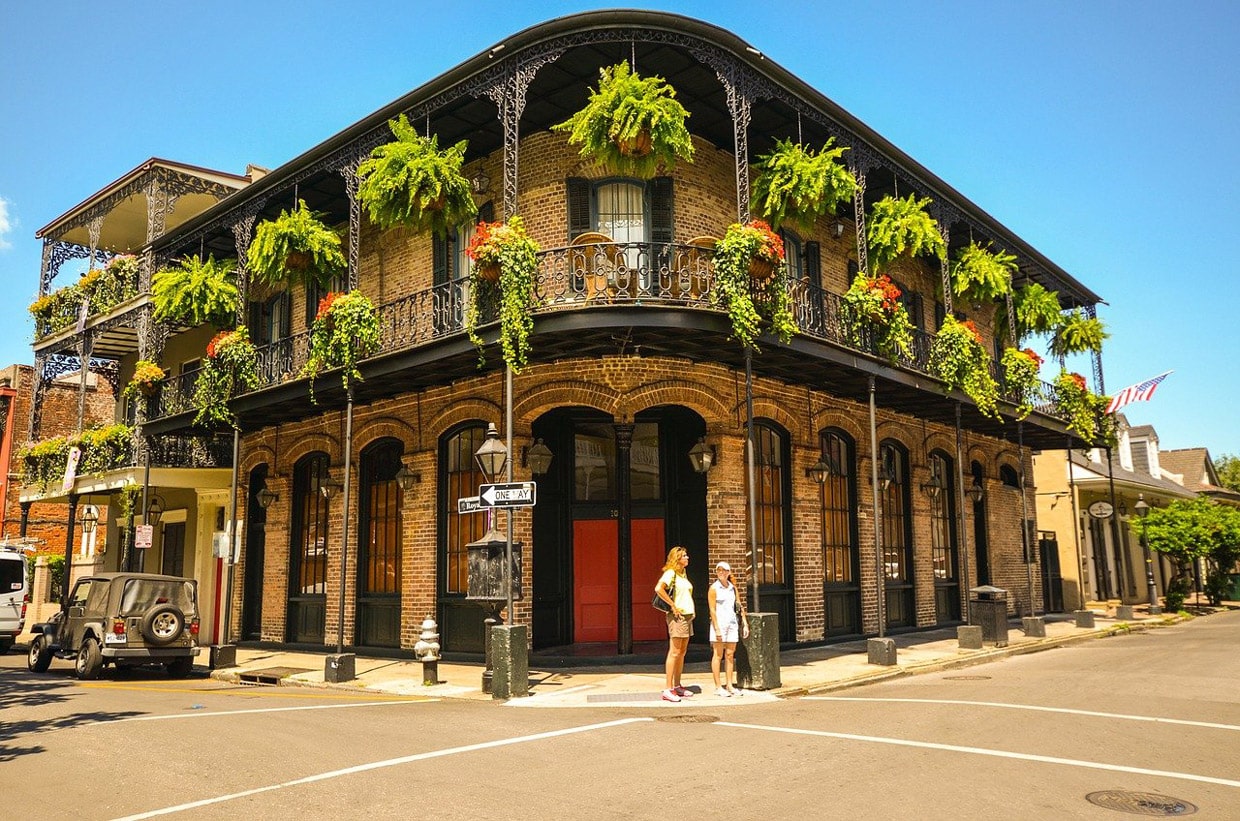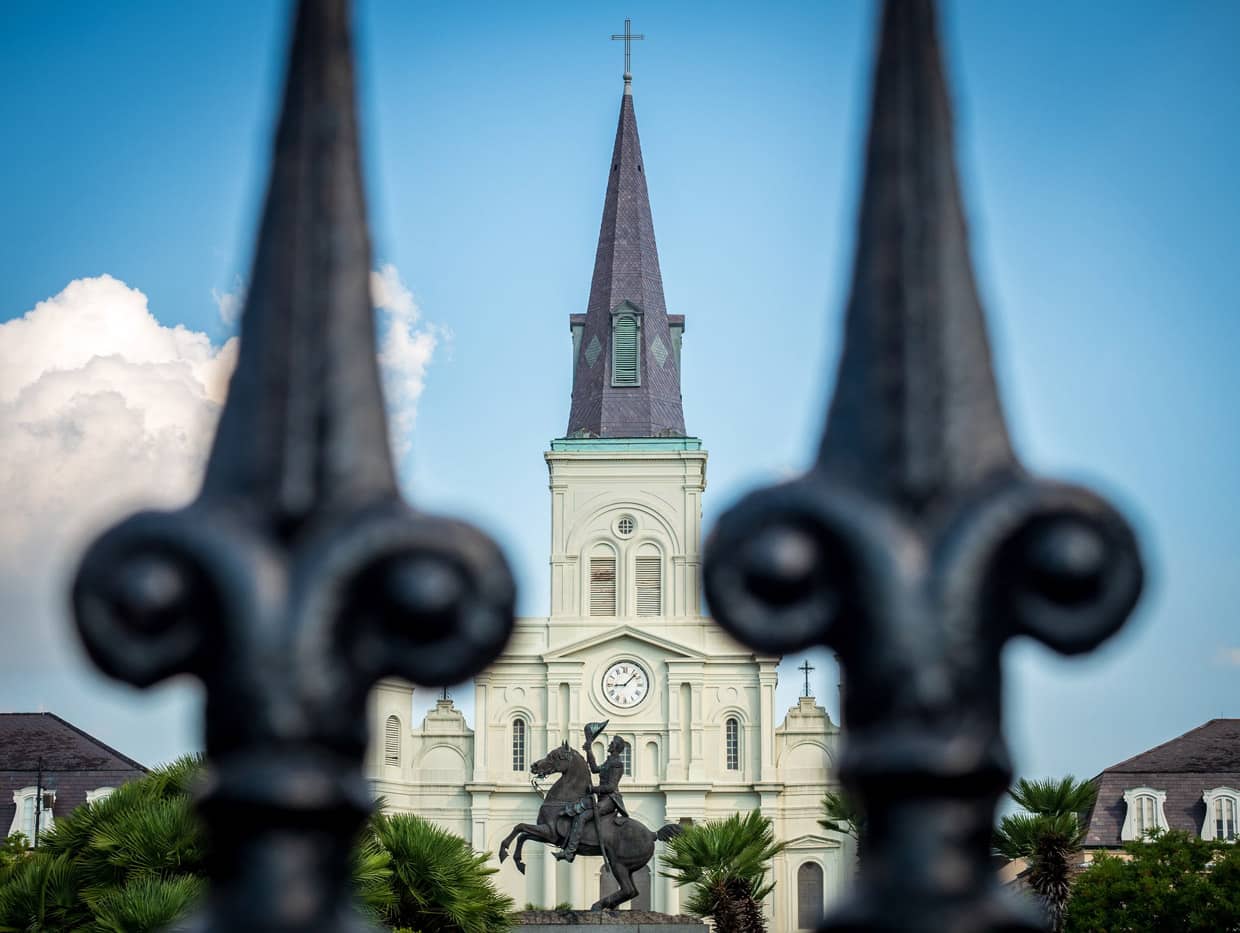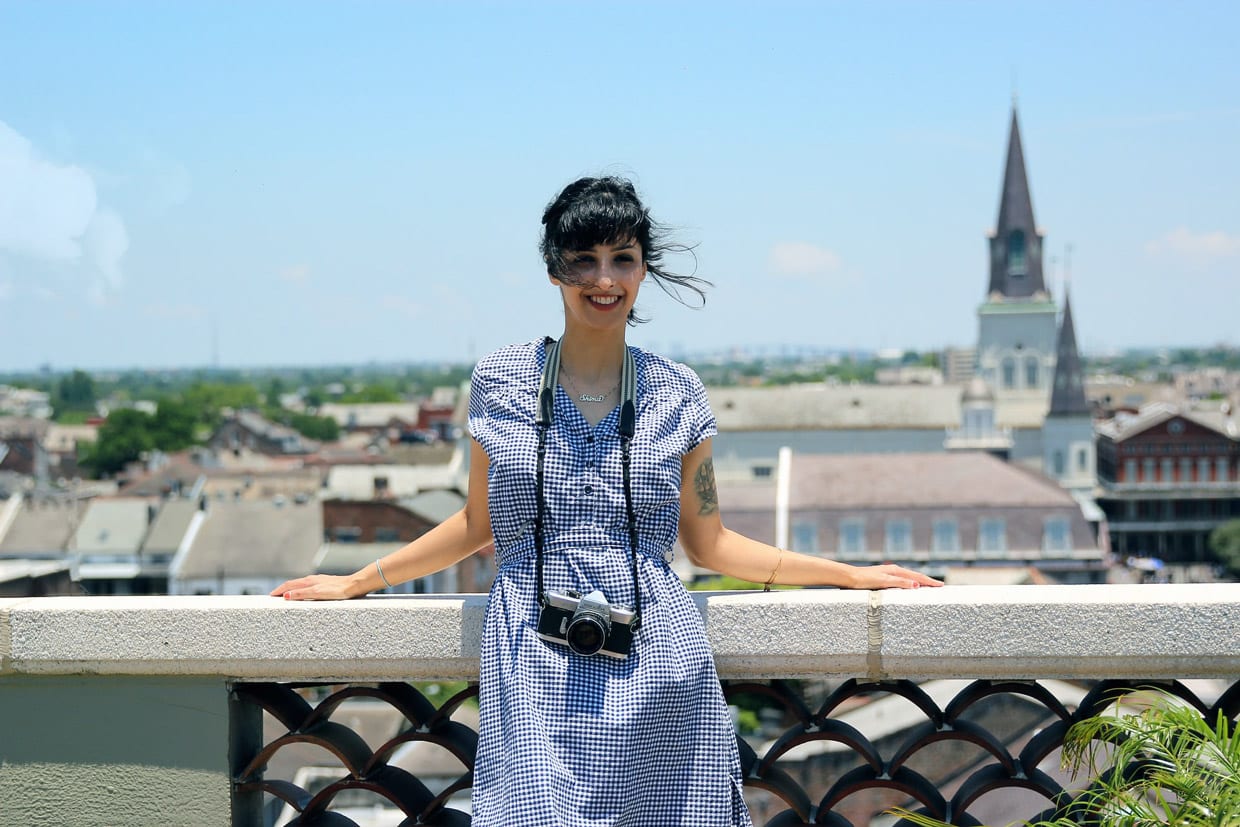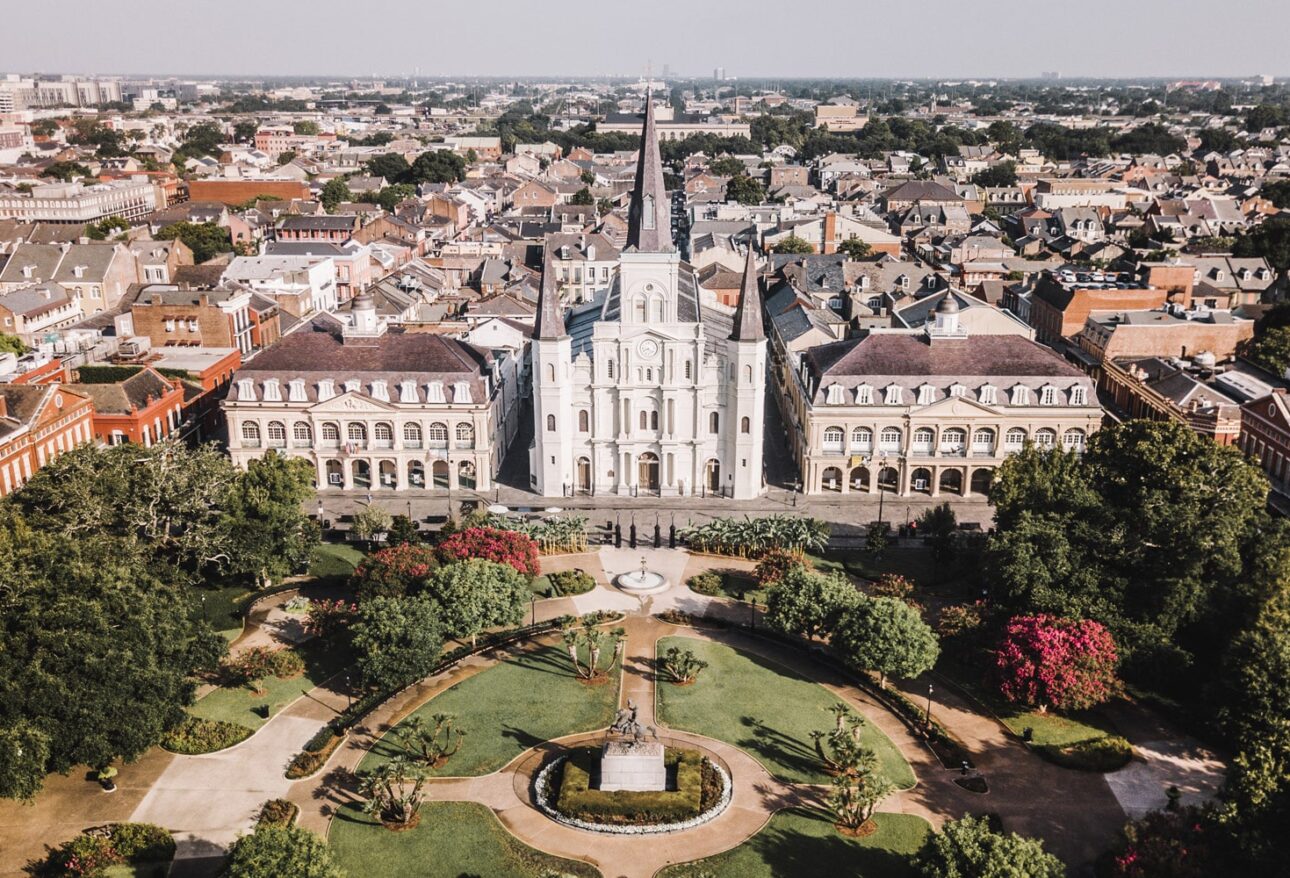French Quarter, sometimes called the Vieux Carré, is a famous quarter in New Orleans, United States. The ancient city of New Orleans gradually developed around the Vieux Carré, a central square, after Jean-Baptiste Le Moyne de Bienville founded it in 1817. It is more commonly referred to as the French Quarter today, or simply “The Quarter,” because of the city’s changes following the Louisiana Purchase in 1803. Buildings of historical significance in the city date mainly from the 18th and early 19th centuries, when Spanish rule dropped, and statehood occurred.
Many buildings within the district have been individually designated as National Historic Landmarks, contributing to the district’s designation as a Whole. Tourists and residents alike enjoy visiting this attraction.
Visitors tend to congregate in the area between Canal Street and Jackson Square, known as The Upper Quarter. Although the Lower Quarter (between Jackson Square and Esplanade Avenue) is primarily residential, it also has shops and restaurants scattered around at the same time.
History
The French took over Louisiana in the 1690s, and Jean Baptiste Le Moyne de Bienville served as Director General and built a colony, known as New Orleans, in the territory. The following year, Adrien de Pauger, the city engineer, laid out the streets of the city.
Following the Seven Years’ War, Spanish troops occupied New Orleans in 1763. A fire in 1788 and another in 1794 destroyed about 80 percent of New Orleans’s city’s structures, and that’s why the French Quarter’s fabric firmly dates from the late 1790s onwards. During the Spanish period, strict new fire codes were introduced that prohibited wood siding or cladding in favor of brick and stucco.
In the French Quarter, French Creoles were already a minority before the Civil War. Many immigrants from southern Italy and Ireland settled in the Quarter towards the end of the 19th century.
Cheap rents and decaying air attracted bohemians to the neighborhood in the early twentieth century. This trend became more pronounced during the 1920s. Most of these new residents participated in the early preservation efforts, which started around that time.
Getting There and Getting Around
Taking the streetcar might be your best option for getting there. Taking the Orleans Avenue or Vieux Carré exit will lead you to the Quarter. The best way to discover the Quarter is on foot. If you decide to drive within the Quarter, watch for pedestrians and bikes, as well as expect it to be slow. The Quarter is highly accessible by bike, but again, use caution.
Two key avenues run through the core of the French Quarter, Bourbon Street and Royal Street. Sections are often closed to motor vehicles. When Royal and Bourbon are crowded, pedestrians often find that parallel Chartres Street is a better option. Jackson Square is the heart of the Quarter.

Attractions
Jackson Square
Known as Jackson Square, this is the area where St Louis Cathedral and the statue of Andrew Jackson are centered. This Square is a lively, energetic place full of street artists, fortune tellers, busker brass bands, and friendly street performers. There are two long brick buildings on either side of the Square, a block-long by four stories, built in the late 1840s. These beautiful rented apartments are supposedly among the oldest in the United States. The ground floor of the building contains shops. St Louis Cathedral, a historical cathedral, is a notable monument on the Square.
St Louis Cathedral
One of the most exciting things to see in the French Quarter is St. Louis Cathedral. This Cathedral is the oldest continuously running Catholic Cathedral in the United States. Despite having erected a church on this site since the city’s founding, it was not until after the fire of 1788 when a new church was constructed. The bell, which dates to 1819, is the oldest part of the modern structure, formed in 1850. A unique feature of this Roman Catholic church in the United States is that it faces a square, lending an eerie European touch to the surroundings. A bombing in 1909 damaged Structural glass and gallery interiors.

Bourbon Street
Bourbon Street stretches for 13 blocks and is among the most famous in the world. For most of its history, the street was a residential street of the 1700s to the 1880s. There are still a few Creole families that own properties there today. Nowadays, the modern incarnation of this street includes a row of bars, live music venues, and gentlemen’s clubs. These streets are known for drinking Hand Grenades and Hurricanes.
Royal Street
Royal Street is mostly pedestrian during the daytime. There is no better way than this to stroll through the Quarter, as you can wander through the Royal Street Art Galleries while listening to street musicians performing classics from New Orleans. Looking to your right, at Orleans Ave., you’ll find a statue of Jesus with outstretched arms. This statue is known locally as Touchdown Jesus during football season.
Pirates Alley
Pirates Alley feels like a mere afterthought set among the picturesque streets of the French Quarter, but strolling through it is a classic French Quarter walk. With its boutique shops like Faulkner House Books and historic buildings flanking one side of it, this street is the epitome of French Quarter identity: an incomparable blend of quirkiness and preservation. It is said to be where Andrew Jackson met with pirate Jean Lafitte for a secret pow-wow.
Moonwalk
The Moonwalk is called after former mayor Moon Landrieu – this is no Michael Jackson dance demonstration. A delightful little walk takes you along the Mississippi River, the largest river in North America. New Orleans characters and people usually stroll about here, whether they are performing, having a picnic, or walking the town. This is a great place to spot a riverboat and snap a picture as you enjoy the scenery.

Mississippi River
Many travel guides do not include the Mississippi River in the French Quarter, but it is impossible to miss. Having almost completed its 2,320-mile grand journey from its source in Minnesota, the mighty river passes along the neighborhood’s edge. There are many attractions of the riverside, including cafes, bars, and open-air festivals.
Cafe du Monde
Occasionally, during busy times at Cafe du Monde (which can vary depending on the season), you may feel a bit overwhelmed. Slowing down, opening your eyes, and enjoying a being in a state of relaxed contemplation is the whole point of sipping a café au lait in New Orleans. Being in line with 40 other people makes it hard to accomplish something such as this. But there is something like magic about visiting du Monde when it’s comparatively slow. We propose a late night or an early morning visit, as it is open 24 hours. It is you, the city, and a treat with much candy to finance several dentist’s offices!
Chart Room
Few bars in the French Quarter have as much charm and authenticity as the Chart Room. You won’t find a more festive scene, nor will you find a more trendy vibe elsewhere in the neighborhood. While they do not serve specialty cocktails or fancy beer, the Chart Room has a go-cup for those of you who need it while roaming the Quarter.
Coop’s Place
New Orleans is a great city to eat your way throughout, and as you do so, you can’t miss Coop’s. There is a combination of Cajun and Creole cuisine on the menu. The interior is designed like a wild hallucination by a barman on a corsair ship. There isn’t any way to go wrong with either meal or drink.
The Cabildo and the Presbytère
Built before the 1788 fire, the Calibado was remodeled beginning in 1795 and named after the Spanish governing body that met here. In the mid-19th century, the Mansard roof, typical of French architecture, was added. The Presbytère was designed to coordinate with the Cabildo. Until 1813, the structure’s second story was still incomplete. Today these structures are home to the Louisiana State Museum, a Hurricane Katrina exhibit, and Mardi Gras Museum.
French Market
The French Market used to be a vast open-air bazaar that shoppers could gather for their daily provisions back in the day when the French Quarter was a residential neighborhood. Nowadays, the Market has two parts: on the upstream side, there are artist stalls and food stands to showcase local artisans and cuisine, and on the downriver side, there is a flea market filled with souvenirs, trinkets and African wood carvings of all kinds. There is a little plaza close to the upriver food stalls called Joan of Arc Park, which features the Lady of Orleans statue.
Le Petit Theatre
Le petit theatre served as a performance venue for a theatrical company founded in 1916. It was one of the first business establishments to open in the French Quarter in an era when the neighborhood was torn between decay and preservation. Throughout the night, guided groups share stories of the Lady in White. Any performances running at the time visit will be announced outside; the stage additionally hosts concerts, comic shows, academic talks, movie screenings, and other one-night-only events. Dickie Brennan’s Tableau Restaurant, situated in the same space in the structure previously utilized as a minor second platform for the theater. Classic Creole cuisine with elevated flare is served here.
New Orleans Historic Voodoo Museum
Near the hustle and bustle of Bourbon Street on Dumaine St, this small two-room building is an affordable option to arouse one’s interest in this supernatural practice. The Voodoo Museum is filled with artifacts, paintings, and sacred objects that examine Voodoo’s fables, myths, and history in New Orleans. One can purchase books, snakeskin, candles, and chicken feet in the nearby gift shop and have fortune-telling carried out by the person who works at the museum as a Voodoo priest.

Nightlife
When the sun sets in the French Quarter, everything gets changed – stores close, the masses move from Royal Street to Bourbon Street, and Dr. Jekyll starts to change into Mr. Hyde. Even though Bourbon is a popular nightlife destination, it is absolutely not the only option. Ghost tours are the most popular choice when it comes to tours during the night in the French Quarter.
While being closed at 10 pm, the French Quarter’s unique, captivating nighttime landscape of gas lamps, shadowy ironwork, and dark corridors will keep many tours running until the last minute. Vampire tours, voodoo tours, cocktail tours, and haunted saloon crawls are among the tours that are offered.
French Quarter nightlife would not be complete without bars and restaurants. Many restaurants have bar areas; however, the actual bars are concentrated on Bourbon Street and Decatur Street. There are nine blocks along Bourbon Street that are lined with bars, restaurants, and nightclubs. It begins flashy and loud and gradually becomes more complex and historic as it continues west. Local gay nightlife revolves around it as well. There’s Lafitte’s Blacksmith Shop at the end of the street, a well-known dive bar where people from all over the world gather. To visit every bar would require several nights’ work.
In Decatur, the lower part between Ursulines and Esplanade is more local-friendly, with beer gardens, restaurants, and craft bars. Also, find Café Envie for a refreshing coffee drink whenever you need to stay up late.
There are several excellent if scattered, options for local music in the French Quarter. Besides Preservation Hall on Bourbon Street, the Bombay Club is a piano bar with an eclectic cocktail list, and 21st Amendment is a music venue.
Another French Quarter classic, live burlesque, might also be offered in the evenings at venues like the One-Eyed Jack’s, the House of Blues, or Jazz Playhouse.
Many buildings within the district have been individually designated as National Historic Landmarks, contributing to the district’s designation as a Whole. Tourists and residents alike enjoy visiting this attraction.
French Quarter is dense. It is possible to come for several days and have a pleasant stay here. If the French Quarter is where your hub is, think about leaving your car behind if you are healthy enough to walk a few blocks in place. It is challenging, costly, or both to park. Streetcar or cab trips are available occasionally to take you to other areas of town. There are many pedestrians in the neighborhood. Walk with caution at night, especially on streets that appear to be deserted. After drinking, it is advisable to take a taxi.
Visitors tend to congregate in the area between Canal Street and Jackson Square, known as The Upper Quarter. Although the Lower Quarter (between Jackson Square and Esplanade Avenue) is primarily residential, it also has shops and restaurants scattered around at the same time.






